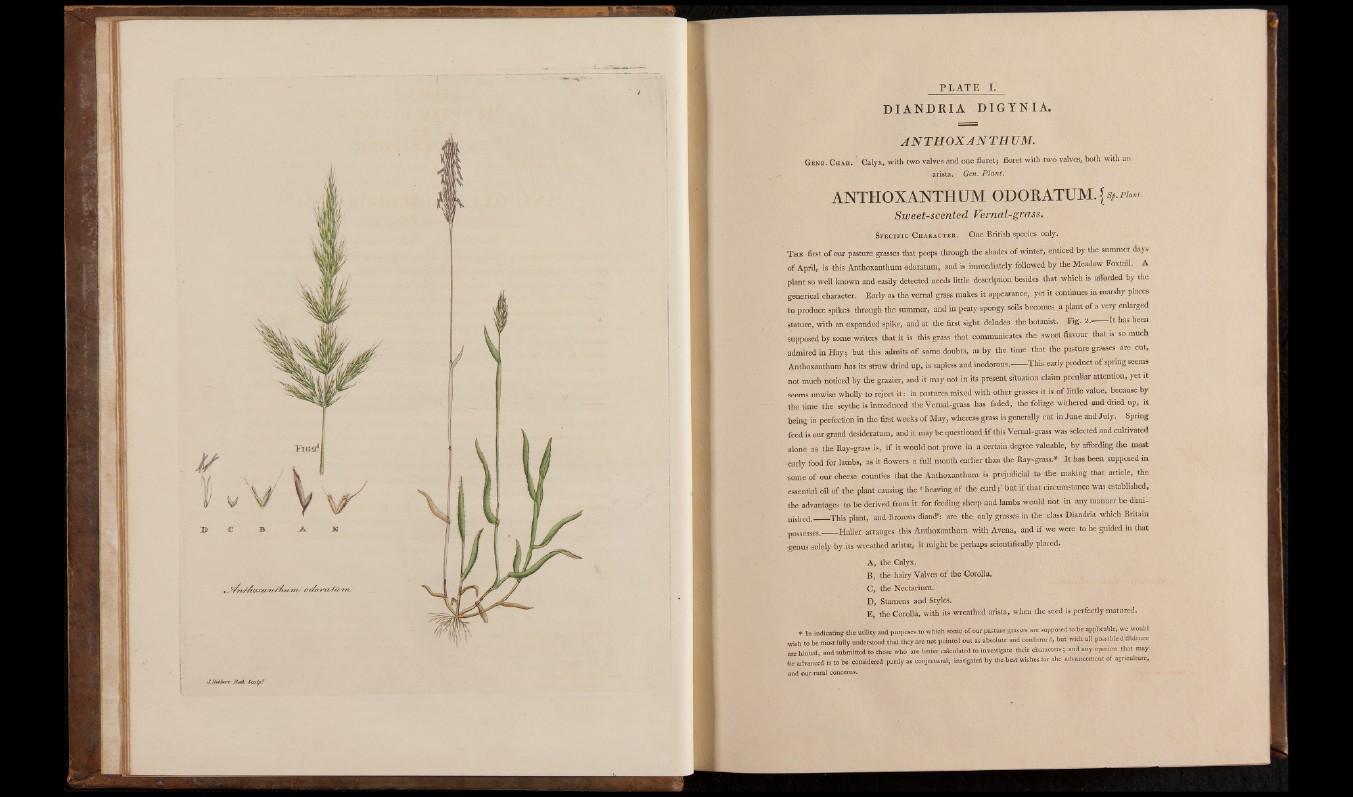
J.Jtlbbcrc J$a8i Sculp!'
D IA N D R IA DIGYNIA.
A N TH O X A N TH UM .
Gene. Char. Calyx, with two valves and one floret; floret with two valves, both with an
arista. Gen. Plant.
ANTHOXANTHUM ODORATUM. {sP.viai
Sweet-scented Vernal-grass.
Specific Character. One British species only.
T he first of our pasture grasses that peeps through the shades o f winter, enticed by the summer days
o f April, is this Anthoxanthum odoratum, and is immediately followed by the Meadow Foxtail. A
plant so well known and easily detected needs little description besides that which is afforded by the
generical character. Early as the vernal grass makes it appearance, yet it continues in marshy places
to produce spikes through the summer, and in peaty spongy soils becomes a plant o f a very enlarged
stature, with an expanded spike, and at the first sight deludes the botanist. Fig. 2 - It has been
supposed by some writers that it is this grass that communicates the sweet flavour that is so much
admired in Hay; but this admits o f some doubts, as by the time that the pasture grasses are cut,
Anthoxanthum has its straw dried up, is sapless and inodorous.------ This early product of spring seems
not much noticed by the grazier, and it may not in its present situation claim peculiar attention, yet it
seems unwise wholly to reject it: in pastures mixed with other grasses it is of little value, because by
the time the scythe is Introduced the Vernal-grass has faded, the foliage withered and dried up, it
being in perfection in the first weeks o f May, whereas grass is generally cut in June and July. Spring
feed is our grand desideratum, and it may be questioned if this Vernal-grass was selected and cultivated
alone as the Ray-grass is, if it would not prove in a certain degree valuable, by affording the most
early food for lambs, as it flowers a full month earlier than the Ray-grass.* It has been supposed in
■some of our cheese counties that the Anthoxanthum is prejudicial to the making that article, the
essential oil of the plant causing the ‘ heaving o f the cu r d b u t if that circumstance was established,
the advantages to be derived from it for feeding sheep and lambs would not m any manner be diminished.—
—This plant, and Bromus diand*: are the only grasses in the class Diandria which Britain
■possesses.____Haller arranges this Anthoxanthum with Avena, and if we were to be guided in that
•genus solely by its wreathed aristae, it might be perhaps scientifically placed.
A, the Calyx.
B, the hairy Valves o f the Corolla.
C, the Nectarium.
D, Stamens and Styles.
E, the Corolla, with its wreathed arista, when the seed is perfectly matured.
* In indicating the utility and purposes to which some of our pasture grasses are supposed to be applicable, we would
wish to be most fully understood that they are not pointed out as absolute and confirmed, but with all possible diffidence
are hinted, and submitted to those who are better calculated to investigate their characters; and any opinion that may
-be advanced is to be considered partly as conjectural, instigated by the best wishes for the advancement of agriculture,
and our rural concerns.